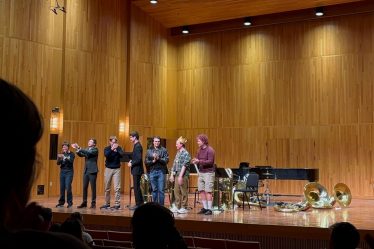Elena Morey
A&E Editor
From the creative mind of James Wan, “The Nun” is another chapter in the horrifying “Conjuring” series. The film as a whole ties seamlessly back into the first “Conjuring” film and leaves the viewer chilled to the bone. In this installment, director Corin Hardy focuses on three characters. The first is an older priest, played by Damain Bichir, sent by Rome to investigate the suicide of a young nun in Romania. The second is a girl who has not yet taken her vows as a nun, played by Taissa Farmiga. She is approached by the priest to assist him in Romania. The final character is none other than the evil creature the girl and the Father battle against, played by Bonnie Aarons.
For those who have seen the other films in the series, this final character is no laughing matter. The entity has appeared most prominently in “The Conjuring 2” and tormented the main series protagonists, Ed and Lorraine Warren. To real-life horror fans, the Warrens are not to be taken lightly. Their work to this day has held quite an impact in the world of the religious and supernatural.
“The Nun” begins by shedding light on the darkness in the Father’s past, which he struggles to overcome throughout the film. This heightens the conflict when the third character is introduced. His standoffish and grisly attitude grounds the Father into the plot with great strength, which radiates off all other characters. The girl, who later takes her vows, also struggles to find her faith and power through the torment. The two possess strong on-screen chemistry that is quite obvious. It is a father-daughter relationship that the viewer cannot help but want to see succeed.
What really makes this installment disturbing and haunting is the spectacular performance and portrayal of the Nun herself. Aarons’ performance was very physical and non-speaking. The makeup team and special effects workers enhanced Aarons’ physicality to create the horrific and iconic look of the Nun. The demon takes the shape of something holy, yet there is nothing holy about this character. Her appearance is truly haunting.
The classic thematic elements of Hardy’s work remain spectacular in his depiction of true horror. He does not shy away from playing with framing and composition of each shot. The mind’s eye fears space and the unknown. Hardy’s frames contain a ratio of figure and space. Often, the subject or person in the shot only takes up one-third or half the composition. The background is out of focus and often darker than the figure. When used to create suspense of what could be lurking around the figure, Hardy’s beauty shines through the scary plot.
As a filmmaker, he goes beyond just jump scares and thrills. Hardy makes use of so much more. Not only using composition, he utilizes the music to control the ambiance of the viewers. Binaural brain beats often manipulate the way people experience the world around them. Most hear these on a daily in their environments. However, some can strongly manipulate the human mind. Hardy has not shied away from using these to heighten the scare element of the music in his films. Going unnoticed to the human ear, these beats excite the parts of the brain that trigger fear, the fight or flight response and/or anger.
In all, the film ties in perfectly with the rest of the “Conjuring” series and enhances the works as they continue. The fright and terror truly remains with the viewer even after having left the theater.

